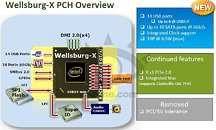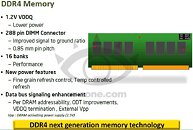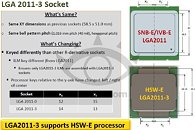Sunday, June 16th 2013

Haswell-E - Intel's First 8 Core Desktop Processor Exposed
Another day, another Intel leak and a few surprises as well. During the last few days we covered Intel's desktop roadmap for the next twelve months, bringing you news and insights on Intel's plans for the aforementioned time interval. Today we bring you news on what's to follow in the second half of 2014, specifically, on Intel's Premium Desktop plans for the interval, namely Haswell-E, DDR4 and the X99 PCH.
Haswell-E will be Intel's last and best offering using the 22 nm fabrication process, it will come in two versions, core count wise, 8 core part(s) as well as 6 core part(s) with hyper-threading enabled, therefore, boasting no less that 16 execution threads for the 8 core chips and 12 execution threads for the 6 core version(s). Judging by that alone, Haswell-E should constitute a far superior upgrade over Ivy Bridge-E, compared to what the latter will be in relation to Sandy Bridge-E, Haswell-E offering two additional physical cores that translate into four additional execution threads. The new chips will boast 2.5 MB of L3 Cache per core, summing up to 20 MB total L3 cache for the 8 core parts. TDP will remain in the same neighborhood it was in the case of its predecessors, around 130-140 W.Haswell-E will of course be accompanied by a new platform, dubbed Wellsburg, the X99 chipset will bring a host of new features, the most important one being quad channel DDR4 support. With four basic frequency settings, starting at 1333 MHz and moving up in increments of 266 MHz to a maximum of 2133 MHz, at which point overclocking should be employed to attain superior clocks. However we sincerely doubt that any DDR4 modules/kits, clocked below 2133 MHz, will be made available for this platform. Modestly clocked (1333 MHz), low voltage (1.2 V) kits are supported by the new platform as well. The DIMM connector was also modified to support Non Volatile DIMMs, receiving four more pins for the purpose (288 instead of 284), modification that will not negatively impact compatibility with 284 pin modules in any way.
Other points of interest regarding the X99 chipset are:
Given the information at hand, trying to quantify performance gains, speculate on overclocking potential and other such conclusory attempts to wrap up the above presented information, I admit is quite enticing and intriguing, but I'll end here and outsource the pleasure of doing that to you.
Post Scriptum
A big hand for radrok, for bringing this to my attention.
Source:
VR Zone
Haswell-E will be Intel's last and best offering using the 22 nm fabrication process, it will come in two versions, core count wise, 8 core part(s) as well as 6 core part(s) with hyper-threading enabled, therefore, boasting no less that 16 execution threads for the 8 core chips and 12 execution threads for the 6 core version(s). Judging by that alone, Haswell-E should constitute a far superior upgrade over Ivy Bridge-E, compared to what the latter will be in relation to Sandy Bridge-E, Haswell-E offering two additional physical cores that translate into four additional execution threads. The new chips will boast 2.5 MB of L3 Cache per core, summing up to 20 MB total L3 cache for the 8 core parts. TDP will remain in the same neighborhood it was in the case of its predecessors, around 130-140 W.Haswell-E will of course be accompanied by a new platform, dubbed Wellsburg, the X99 chipset will bring a host of new features, the most important one being quad channel DDR4 support. With four basic frequency settings, starting at 1333 MHz and moving up in increments of 266 MHz to a maximum of 2133 MHz, at which point overclocking should be employed to attain superior clocks. However we sincerely doubt that any DDR4 modules/kits, clocked below 2133 MHz, will be made available for this platform. Modestly clocked (1333 MHz), low voltage (1.2 V) kits are supported by the new platform as well. The DIMM connector was also modified to support Non Volatile DIMMs, receiving four more pins for the purpose (288 instead of 284), modification that will not negatively impact compatibility with 284 pin modules in any way.
Other points of interest regarding the X99 chipset are:
- Up to six USB 3.0 ports
- Up to eight USB 2.0 ports
- Up to ten SATA 6 Gbps ports
- Integrated Clock support
- TDP of 6.5W
Given the information at hand, trying to quantify performance gains, speculate on overclocking potential and other such conclusory attempts to wrap up the above presented information, I admit is quite enticing and intriguing, but I'll end here and outsource the pleasure of doing that to you.
Post Scriptum
A big hand for radrok, for bringing this to my attention.




77 Comments on Haswell-E - Intel's First 8 Core Desktop Processor Exposed
As an owner of a SB-E rig I can say, once again, that your hate for skt2011 and X79 is really pretty ridiculous. Even more so for someone who has never owned a skt2011 machine, so you really have no idea what you're talking about because it feels just as responsive as a skt1155 rig. I don't know what you're beef is, but skt2011 does not suck. Just because it doesn't have everything you ever wanted doesn't mean it is bad and unlike you, I actually have a ton of devices plugged into the PCH and I do a an X79 board and I can say that it performs admirably, so don't talk about what you don't know.
--
As far as the new Haswell-E revision of skt2011 is concerned, that would have been expected with the introduction of DDR4 so I'm not surprised in the slightest. I would also imagine that Haswell-E is probably, at bare minimum, at least a year away.Why? DDR4 works very differently than DDR3. They're ditching channels in favor of point-to-point links. That requires redoing the circuitry.
2011 is a completely different platform.
ark.intel.com/products/64597/Intel-Xeon-Processor-E5-2665-20M-Cache-2_40-GHz-8_00-GTs-Intel-QPI
They realy should of just kept skt 1155 for Haswell and Broadwell as well, that would of been a realy good socket to keep then? Not like there is a huge difference between them all is there?
No SATA Express?! The next extreme generation won't support it while the new mainstream one (Z97) will?! someone there in Intel got crazy. The next SSD's will be capable to exceed SATA3\6G speed, and the most common owners ones (the Extreme platforms users) won't be able to make a use of them?
ABSURD.
Check out the Xeon E5-2697v2 when it's officially announced in the near future.
Anyway still good news and i might upgrade to this if my wallet allows at the time.
Thanks. Appreciate the quick reply.
Secondly, can you even read? People are complaining that Haswell-E CPUs will not work with current LGA 2011 boards, not the fact that their 3930/3820Ks are not forwards compatible with HW-E socket mobos. That's the equivalent of trying to stick a AM3 CPU in an AM2 motherboard -- not physically possible due to socket layout & feature changes. It is one thing to complain about occasional socket changes from Intel (I complained about it a fair bit back when 1156 was EOL'd & 1155 was announced, and for good reason) but for you to troll with your moronic "AMD is teh bestt cuz my CPU wurks on 2 socketz!!!1!!" is beyond retarded -- you swapped 3 motherboards to use the same slow-end CPU, and AM3+ is pretty much a fake socket, since 900 series chipset motherboards are merely re-branded 800 series anyway (with a slightly overclocked HyperTransport bus). Nothing there warrants a new socket anyway.How can you possibly say something so stupid? Did you even see that this new socket will use DDR4? Or the fact that Haswell houses certain voltage regulators on-die, which easily justifies a new socket on its own? Who are you trying to kid, other than yourself?
Welcome to the 21st century. Memory controllers have been on CPUs since around 2008 for Intel, and all the way since at least 2003/04 from AMD.
LGA 1366/1156 - Nehalem and Westmere
LGA 2011/1155 - Sandy Bridge and Ivy Bridge
LGA 2011-3/1150 - Haswell and presumably Broadwell
One socket gets two architectures (a new one, then die shrink). The grand old days of LGA 775 don't exist any more. This isn't a great thing for purchasing, but it is a very good thing for performance. If you'd like to go the "AMD has better backward compatibility" route I'd like to ask you how you expect new features, when a chip is locked into a six year old socket. If you don't subscribe to this theory then you can purchase an AMD setup.
Now, connectivity. Aquinus makes the same point time and again, which I happen to disagree with. Rather than rehash this, I'll just say X79 was intentionally crippled by Intel, due to heat. This is the same reason all SB-e 6 cores are 8 cores with two cores lasered off. That's a disappointment to me, but seems to be justified as "an expense inherent in the enthusiast level market." I cannot abide this.
No Thunderbolt, no problem. Intel requires an IGP to get Thunderbolt to work. It produces insane amounts of heat, and still costs a small fortune to get a device. Firewire is a very apt example of this crap, and Intel seems to be putting it into the same failed experiment shoe box. It's cool, it'll still see some incorporation, but it isn't likely to be adopted by the mainstream. I'm not seeing a huge problem here.
DDR4 is interesting. It would offer a very good reason to restructure the socket. I can't say I'm looking forward to its adoption, but it'll be nice to get DDR3 out of here. Less power consumption, better connection to the memory controller, and higher bandwidth are always nice. Wikipedia lays it out in pretty plain terms for those people who don't know about it already: en.wikipedia.org/wiki/DDR4
Finally, and the biggest caveat, late 2014. Let's assume that the date is, for the sake of calculation ease, November 16 2014. SB-e saw release November 16 2011. You're going to tell me that three years on a platform is insufficient? Socket 1155 ran from January 2011 to June 2013. 29 months as opposed to 36 from LGA 2011. I don't see half as much vitriol for LGA 1150 as LGA 2011. Why? LGA 2011 has its problems, I do feel disappointed, but I don't feel cheated. LGA 2011 is not a home run, but it is a solid base hit for people who want something more than a gaming rig.
Edit:
Changed spelling.
All I can say is about damn time Intel.Agreed!
:toast: